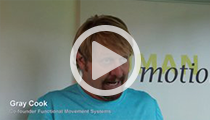Functional Movement Screen - Level 1
THE MOVEMENT EXPERIENCE
UPDATED COURSE!
AC Milan (ITA) Bayern Munich (GER), Borussia Dortmund (GER), Ajax Amsterdam (NED), Liverpool, Tottenham Hotspur, Aston Villa, Wolverhampton Wanderers en andere Premier League clubs zijn u reeds voorgegaan!
FMS is een screening tool om beperkingen en asymmetrie te identificeren in zeven fundamentele bewegingspatronen die essentieel zijn voor de functionele kwaliteit van beweging bij personen zonder pijnklachten of blessures van het bewegingsapparaat.
Deze bewegingspatronen zijn ontwikkeld om waarneembare prestaties van fundamentele loco motion, manipulatieve en stabiliserende bewegingen te beoordelen door het individu te plaatsen in extreme posities waar zwakke punten en disbalans merkbaar worden wanneer mobiliteit en motorische controle niet goed zijn.
De kern van de screen is het benadrukken van kwaliteit van beweging boven kwantiteit en om bewegingsdeficiënties en beperkingen te identificeren. Aangezien het lichaam complex van aard is en werkt als een systeem, is het noodzakelijk om bewegingspatronen te verbeteren als geheel, in plaats van alleen maar geïsoleerde gewrichtstesten uit te voeren om beperkingen te bepalen. De FMS is een makkelijk toepasbaar instrument dat gebruikt kan worden voor het bepalen van een geschikt oefenprogramma voor elk individu.
Deze cursus is geschikt voor (sport)fysiotherapeuten, manueel therapeuten en personal trainers.
Day One
8:30 Registration and Greeting Attendees
9:00 – 10:00 :
I. Movement Principles
a. Overview of Movement expression in daily life.
b. How do we lose normal movement?
c. What does poor movement expression look like?
d. What is movement literacy and why is it important?
e. Describe how fundamental movement principles guide the process of improving and maintaining quality movement.
f. History of Functional Movement Screening
10:00-10:45 :
II. Movement Appreciation – A Practical Lab
a. Discuss and describe how bases of support, postures and positions effect movement
b. How does Intensity and volume affect these patterns?
c. Q&A Discussion: How has your environment, training, or injury history affected your movement, behavior, and training?
10:30 – 10:45 Break
10:45 – 12:30:
III. The Symmetrical Stance Pattern
a. Describing this pattern
b. Where do we see the Symmetrical Stance Pattern expressed in daily life?
c. How does daily activities/training affect the Symmetrical Stance Pattern?
d. The Deep Squat Test
IV. Double-to-Single Leg Stance Pattern
a. Describing this pattern
b. Where do we see the Double-to-Single Leg Stance Pattern expressed in daily life?
c. How does daily activities/training affect the Double-to-Single Leg Stance Pattern?
d. The Hurdle Step Test
12:30-1:30 Lunch
1:30-5:00
V. The Split Stance Pattern
a. Describing this pattern
b. Where do we see the Split Stance Pattern expressed in daily life?
c. How does daily activities/training affect the Split Stance Pattern?
d. The Inline Lunge Test
VI. The Upper-Limb Reciprocal Pattern
a. Describing this pattern
b. Where do we see the Upper -Limb Reciprocal Pattern expressed in daily life?
c. How does daily activities/training affect the Upper-Limb Reciprocal Pattern?
d. Shoulder Mobility Test
VII. The Lower-Limb Reciprocal Pattern
a. Describing this pattern
b. Where do we see the Lower-Limb Reciprocal Pattern expressed in daily life?
c. How does daily activities/training affect the Lower-Limb Reciprocal Pattern?
d. Active Straight Leg Raise(ASLR) Test
VIII. The Reactive Sagittal Plane Stability Pattern
a. Describing this pattern
b. Where do we see the Reactive Frontal Plane Stability Pattern expressed in daily life?
c. How does daily activities/training affect Reactive Frontal Plane Stability?
d. Trunk Stability Push-Up Test
IX. The Reactive Tri-Planar Stability Pattern
a. What specific pattern is this?
b. Where do we see Reactive Tri-Planar Stability Pattern expressed in daily life?
c. How does daily activities/training affect Reactive Tri-Planar Stability?
d. Rotary Stability Test
DAY TWO
8:30 – 10:00:
I. Pulling all 7 Test Together (Lab)
a. Discuss all seven tests and their relationship
b. How to begin the FMS – 4 statements
c. Running your best FMS Tips
d. Demo Full Screen – use software for documenting scores (25 min, if Pro 360 and Wi-Fi are available, if not simply do a full demo)
e. Each group performs a full screen on each participant
10:00-10:15 Break
10:15-12:15:
II. Motor Control Screen – PowerPoint, Demo and Lab III. Applying FMS Results
a. Corrective Strategies
b. Example of the Training Cycle – one pattern
12:15-1:15 Lunch
1:15-2:45:
IV. Practical Lab
a. Case Study using FMS Results
b. Corrective Strategies Example
2:45-3:15:
V. What to expect after the course?
a. Certification Exam Details
b. Member Benefits
c. Integrating into your business d. Next Steps
VI. Q&A
Wat doet het? De brede voordelen van het systeem:
De FMS versimpelt het concept van beweging en de impact daarvan op het lichaam. De slimheid van het systeem heeft voordelen voor zowel individuen, als de (sport)fysiotherapeuten en exercise professionals.
Communicatie: de FMS gebruikt eenvoudige taal, wat het eenvoudig maakt voor iedere gebruiker van het systeem op moment dat er gesproken wordt met elkaar over scores, progressie en behandeling.
Evaluatie: de screen identificeert op snelle wijze asymmetrie en beperkingen, wat langdurig testen en analyseren overbodig maakt.
Standaardisatie: de FMS creëert een ‘functional baseline’ om progressie te zien en biedt de mogelijkheid om performance te meten.
Veiligheid: de FMS kan snel een potentieel gevaarlijk bewegingspatroon analyseren zodat deze hersteld kan worden. Het is eveneens een indicator om te zien of een individu klaar is om te gaan sporten en om realistische te doelen te stellen en te halen.
Correctie strategieën: de FMS kan voor elk training- en fitness niveau gebruikt worden. De corrective exercises zijn geschikt voor een breed scala van bewegingsissues. Het identificeert specifieke oefeningen die gebaseerd zijn op individuele scores om altijd op maat gemaakte (behandel)programma’s te maken.
FMS certificatie
Als u FMS gecertificeerd bent leert u optimaal gebruik te maken van de efficiëntie en de bewezen resultaten van het systeem. U heeft toegang tot de FMS community, de research area, die constant wordt geüpdate en de database met de diagnostische tools en oefeningen die de basis vormen van het FMS systeem.
Website Functional Movement Systems: http://functionalmovement.com/fms
Er staan geen cursussen gepland. Vul uw gegevens in om op de hoogte te blijven van nieuwe cursussen.





